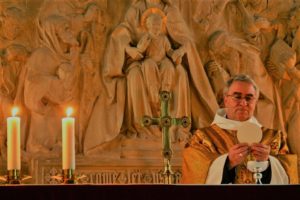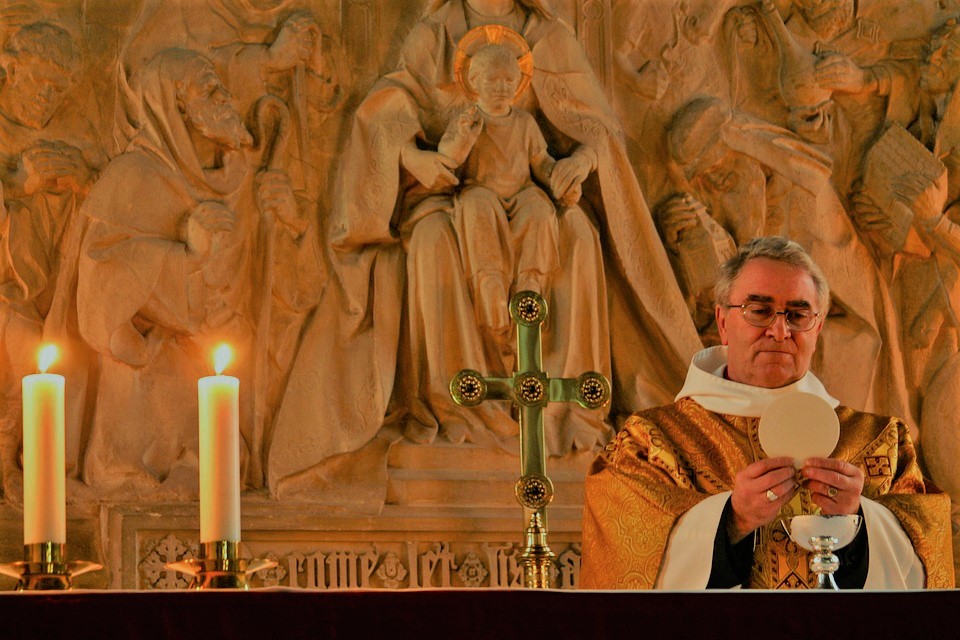 In the afterglow of Corpus Christi, we do well to consider some of our liturgical practices. Over the years on this blog we have done a good deal of this (e.g., Worthiness to receive Communion).
In the afterglow of Corpus Christi, we do well to consider some of our liturgical practices. Over the years on this blog we have done a good deal of this (e.g., Worthiness to receive Communion).
In this post, I would like to consider three rather obscure but still important moments that are often lost in the minds and hearts of the faithful – the Mystery of Faith, the Amen, and the Agnus Dei. They rise in importance because they are moments that belong especially to the faithful rather than the clergy.
I. The Mystery of Faith (Memorial Acclamation)
In the Ordinary Form of the Liturgy, an acclamation of the people has been added just after the consecration. The priest bids them to acclaim the paschal mystery that has just been made present in the Eucharistic Sacrifice. He says or sings “The mystery of faith.” At this point the rubrics indicate “And the people continue, acclaiming …” Note that it is not anticipated that the priest should join them. At other times the rubrics do dictate that the priest and people sing together. (For example, at the Sanctus the rubric states, “[The priest] joins his hands and concludes the Preface with the people, singing or saying aloud …”)
But in the case of the Mystery of Faith, the rubric simply says, “the people continue, acclaiming …” There are three options:
1. We proclaim your death or Lord, and profess your resurrection, until you come again.
2. When we eat this Bread and drink this Cup we proclaim your death O Lord, until to come again.
3. Save us Savior of the world, for by your Cross and Resurrection, you have set us free.
While these acclamations are relatively new in the Roman Missal (introduced in 1970), they echo the practice of the Eastern Churches, which contain several acclamations by the people during the Eucharistic Prayer (specifically the Anaphora). For example, in the Liturgy of St. John Chrysostom, the people sing “Amen” after the consecration of the bread and again after the consecration of the wine. The priest then sings, Thine own, of thine own, we offer unto thee, on behalf of all and for all. And the people respond, We praise thee, we bless thee, we give thanks unto thee and and we pray unto thee, Lord our God.
The memorial acclamation in the Ordinary Form of the Mass, the inclusion of which was not without controversy (I have written on this before), is an important moment for the people to acclaim the paschal mystery that has just been made present to them. Too often, unfortunately, they seem distracted or uninvolved. Clergy should not usurp the acclamation for themselves by singing it too loudly. Even if it is necessary to “get the people started,” the priest should then pull back and listen reverently to the response that really belongs to the congregation. This is a moment for the people of God to express their praise and worship of the Lord, now on the altar, in a reverent fashion. It does belong to us clergy to instruct the faithful on the meaning and importance of this moment in terms of Eucharistic piety.
II. Amen
The Amen at the end of the Eucharistic prayer is another moment for God’s people to acclaim their “yes,” solemnly and joyfully, to what has just taken place. In this case as well, the speaking or the singing of the “Amen” is assigned to the people, not the clergy. The rubrics state, “The people acclaim: Amen.”
The celebrant, in persona Christi Capitis, has been speaking to the Father on their behalf, recalling the great works of God and the Sacrifice of the Cross made present in the Eucharist. He has asked mercy for the Church: the clergy and all the people, living and deceased.
At the conclusion, the celebrant and deacon hold aloft the Body and Blood of the Lord and sing or say, Through him and with him and in him, O God almighty Father, in the unity of the Holy Spirit, all glory and honor is yours, forever and ever. It is for the people, not the celebrant, to acclaim “Amen.” It is their “yes,” their acknowledgment of all that has been said and has taken place.
Thus, the “Amen” ought to be a vigorous one. There is no need for histrionics, but a good, firm “Amen” is surely called for as a sign of our Eucharistic faith and our grateful spirits. At times, though, it seems one can barely detect the joy and firm affirmation that is deserved. Eucharistic piety demands more than a distracted, feeble “Amen.”
III. The Agnus Dei
Just prior to the Agnus Dei, the optional (though seldom omitted) sign of peace is sung or said. Unfortunately, there are often excesses in what ought to be a modest greeting to those immediately nearby. These excesses often lead to the eclipse of what is a beautiful and pious hymn of preparation for Holy Communion: Lamb of God you take away the sins of the world, have mercy on us … grant us peace.
The recitation or singing of the Agnus Dei begins just after the sign of peace, but many people do not take the hint to refocus and join in. Instead they continue glad-handing as if it were merely background noise/music to the sign of peace. It is not. It is part of a eucharistic piety meant to prepare us for Holy Communion. Consider that the words of the hymn are very tender. We invoke Him who is the Lamb of God to have mercy on us and grant us peace to approach the Eucharistic altar without servile fear.
The Agnus Dei is especially a song of the people, because the celebrant is usually busy with other prayers. He may join towards the end, but this is a moment for the people to prepare for Holy Communion.
Here, then, are three acclamations of Eucharistic piety that help frame the liturgy and draw us to devotion. My sense is that they are underappreciated by many of the faithful and that clergy often usurp the role given to the lay faithful here, sometimes even acting as a “song leader.”
Ideally, the faithful can discover their own role here and see that the acclamations are not mere formulae, but prayers of a people who believe and celebrate what is announced.


I ceased attending my parish church (in Washington, DC) when, over several Sundays, I observed many in the congregation engage in an extended “sign of peace” expression as the priest recited ‘Lamb of God…’ largely to himself. People deemed it more important to say things like “Hey Jim, coming over for pizza later?” and “Peace be with you. Can’t wait for the Redskins/Cowboys!” than give their praise for the miracle before them.
I agree that people should be instructed on the sign of peace; I have never in
my life heard people discuss pizza or football. The majority of people
in many different parishes I’ve attended actually say Peace. I have never seen anyone crawling over pews. I think much of the problem though comes from the
time when musicians would play a song to accompany the sign of peace. Choirs,
cantors, etc should not start the Lamb of God during the sign of peace.
Ed, I wonder if we attended the same parish! In all seriousness, there is a role for some education from our priests and some reverence and common sense from our laity.
Priests have to pick their battles. In the broad sense, this is a minor quibble.
My young son refusing to participate explained afterwards that the man in front of him was in the bathroom before Mass and neglected to wash his hands-ew! As for myself I was pushed aside so that 2 guys could say “how’s it going?” Peace sign? A huge failure!
It is indeed good within our core to participate in the celebration of The Most Holy Sacrifice of the MASS out of gratitude to HIM Who gave HIS whole being for our salvation. It is even much more good if we consider that others, even those who do not believe, will benefit from our participation as the Church intercedes and reclaim the dignity of humankind the creation of GOD! YHWH EL GIBOR
The consecration at the Divine Liturgy of St. John Chrysostom, St. Basil, and St. James takes place at the Epiclesis, when the Priest calls upon the Holy Spirit to change the bread and wine into the Body and Blood of Christ.
This is the teaching of both the Orthodox Churches and the Catholic Churches of the Byzantine tradition.
I’ve been more aware over the last year or two that while the Eucharistic Prayers are addressed to God the Father, the Memorial Acclamations (embedded in the midst of those prayers) are addressed to the Son. I haven’t come to any firm conclusions about what that difference means, and I’d be interested to hear what others think.
Serious question: why do we do the sign of peace? If it’s so distracting (which it is) and takes the focus away from what is about to happen by receiving communion (which it does), and if it’s optional, why is it even there and why do
Priests “opt-in” 99% of the time?
” why do we do the sign of peace?”
Because…
… it is like the protestant service, more ‘personal’.
… it snaps the sleepy awake.
… it was described by one early mass participant.
… it compliments the holding of hands (see the first one above).
… it promotes the kissing of spouses (but not kissing the lady next to thee, which is discriminatory).
… it makes us feel good about… ah…um…
Why do we do the sign of peace?
Because Jesus says “go first and be reconciled with your brother, and then come and offer your gift” at the altar (Matthew 5:24).
Because Holy Mother Church says so.
Because we want to receive Holy Communion reverently, and it would be irreverent and uncharitable to have such disregard and dislike of the people around us, or also to concern ourselves with the conduct of others.
One of the interesting things about the history of the insertion of the Memorial Acclamation is that some in the Concilium justified it by saying this would substitute for the splitting of the Sanctus between the Sanctus/Benedictus…..